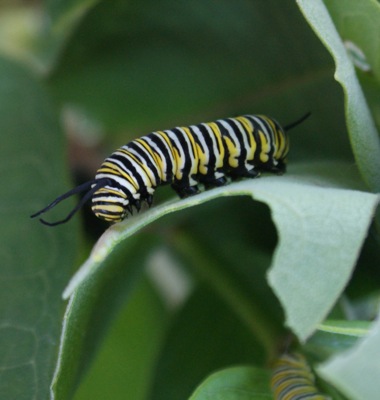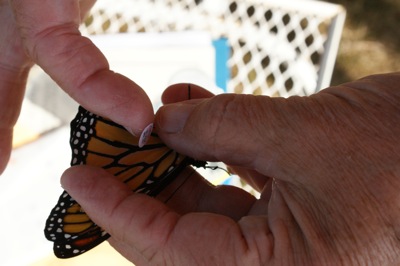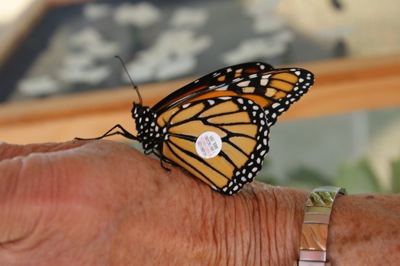Saturday, September 12th, 2009
Monarch mom
St. Marys woman on a crusade to increase butterfly numbers
By Shelley Grieshop

Photo by Shelley Grieshop/The Daily Standard
Jill Bowers, St. Marys, shows a hatched monarch butterfly and several unhatched ones still in their chrysalises clinging to the screen covering her backyard aquarium. Each summer, Bowers gathers milkweed leaves and monarch caterpillar eggs and nurtures them until they change into butterflies.
ST. MARYS - "Monarch Inn" might be the most appropriate name for Jill Bowers's rural home this time of year.
These days her house, garage and backyard are host to containers filled with monarch butterflies in various stages of development. "Monarch Mom," as she is called, nurtures them from tiny eggs, tags their colorful orange and black wings and sends them on their migratory journey to Mexico.
Why would anyone take the time?
"I do it to help the monarchs. I do it for my grandkids," says the 70-year-old mother, grandmother and great-grandmother.
Specie preservation is important to Bowers, who has monitored nesting American bald eagles on Grand Lake since 1995. But once the eagles leave their nests by early July, her monitoring duties for the Ohio Department of Natural Resources are complete for the season.
"I get fired," she says with a laugh. "I have to have something else to do."
Bowers and her husband, John, became interested in monarchs (Danaus plexippus) in 2001 during a walk along the lake.
"My husband found this caterpillar and, of course, we brought it home," she says with a laugh.
First she did some research. She was amazed to find out the monarch butterflies that captivate local residents in late summer will fly south to Mexico in the fall. On their way back, in January or February, they will lay eggs and die. That process occurs at least three times during their return trip, so it is the monarchs' great-great-grandchildren that journey back to the Grand Lake area.
Bowers spends many hours each summer hunting milkweed plants - an essential part of the monarch's well-being. The adult females lay their pinhead-size eggs on the leaves, which also are the sole diet of the emerging larvae or caterpillars.
"I'm always looking for milkweed. I scour ditches and roadways all the time," she says. "I've planted it in our garden but it's never enough to keep me in supply."
Finding milkweed plants can be a challenge in this area. Farmers and road crews consider it a weed and spray it with herbicides, she says.
The metamorphosis that takes place in Bowers' aquariums and buckets is fascinating, she says. Within three to five days the tiny eggs turn into vividly-striped caterpillars - an eye-popping yellow, black and white. They immediately begin to eat enormous amounts of the milkweed leaf.
"Eat and poop, eat and poop, that's all they do," Bowers says with a smile.
Because they grow so fast, the caterpillars molt or "shed their clothes" several times in the next two weeks, she says. During the third week, they enter the pupa stage while hanging in a J-shape by a thin string of the caterpillar's own skin. Gradually the bloated caterpillar turns into a smooth, emerald-green case called a chrysalis.
"It looks like jewelry," Bowers says.
Inside the chrysalis an adult butterfly is formed as the casing turns from black to transparent. About 30 days after the process begins, the adult butterfly "wiggles" its way out, she explains.
"When it hatches, it's all crumpled up at first," Bowers says. "Its belly is big from the liquid it stored and it quickly forces that liquid into its wings. Then, just like that, it spreads its wings out big and beautiful. It's so wonderful to watch."
The butterfly stays damp for a while. After it dries, it looks for nourishment. It is at this stage that Bowers places a tiny tag - "its social security," she says - on its wings before setting it free. The round, all-weather sticker includes a phone and identification number to report where the butterfly is found. A Monarch Watch organization buys the tags from Mexican officials in order to monitor the insect's migration.
If one of Bowers' tags is located, she receives a special certificate through the Monarch Watch program.
"I haven't gotten one yet," she says in a disappointed tone.
Bowers says she tags 200 to 300 monarchs each year, she says. The process ends by November when the last of the eggs have hatched.
It's a tedious task being Momma to so many monarchs, but one she takes seriously.
"To be a part of their life, just like the eagles, even if it's just for an instant, is so gratifying," Bowers says.

Photo by Shelley Grieshop/The Daily Standard
A monarch caterpillar raised by Jill Bowers, St. Marys, munches on a milkweed leaf.

Photo by Shelley Grieshop/The Daily Standard
Jill Bowers, St. Marys, places a tiny tag on the wing of a monarch butterfly at right. Monarch butterflies travel further - up to 3,000 miles - than any other species of butterfly.

Photo by Shelley Grieshop/The Daily Standard
The monarch butterfly below sitting on Jill Bower's hand is tagged and ready to go. Monarch butterflies travel further - up to 3,000 miles - than any other species of butterfly.




